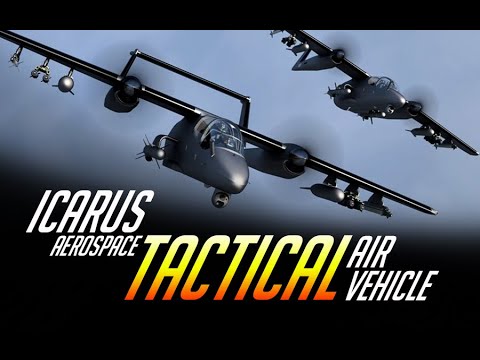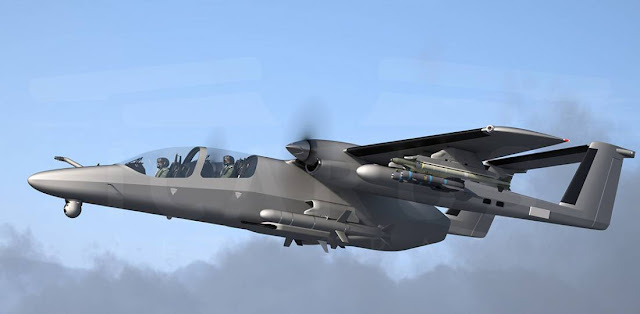La società canadese Icarus ha presentato un velivolo multiruolo a pilotaggio opzionale
Icarus Aerospace, società con sede a Montreal, in Quebec, ha svelato un nuovo aereo militare che descrive come "altamente personalizzabile, versatile, capace e affidabile". Conosciuto come Tactical Air Vehicle (TAV), e come Wasp nel suo overwatch armato completamente militarizzato / Versione di presenza persistente, pilotatile opzionalmente, ha una configurazione a doppio braccio di coda alta, simile all'OV-10 Bronco statunitense dell'era vietnamita.
Il TAV offrirebbe il 90% della capacità di combattimento di un caccia moderno al 15% del costo di utilizzo; potrebbe rivelarsi interessante sia per le grandi forze aeree che cercano un aereo ISR / attacco / marittimo a basso costo, sia per le piccole aviazioni che richiedono un aereo da combattimento versatile in grado di svolgere molti compiti con budget limitati.
E’ spinto da due turboelica nella classe da 1.700 CV, il TAV ha un MTOW fino a 21.000 libbre, una tangenza operativa di 36.000 piedi ed una velocità massima prevista di 360 nodi. La durata senza rifornimento è calcolata in 6,5 ore, ma l'aereo ha una sonda per il rifornimento in volo e capacità di rifornimento aereo automatizzato.
In termini di equipaggiamento, il TAV può essere dotato di un radar Leonardo Osprey AESA a 360 gradi montato in modo conforme e può trasportare una o due torrette di sensori elettro-ottici. Undici hardpoint possono montare una vasta gamma di armi, inclusi missili aria-aria, e c'è un cannone rotante a tre canne montato in una carenatura sul lato inferiore della fusoliera. Un'opzione è un cannone in torretta montato sul lato inferiore, simile a quello provato dalla variante YOV-10D NOGS del Bronco. Il carico utile totale è pari a 8.000 libbre.
Il TAV è stato progettato per operazioni da piste di atterraggio erbose per facilità di spiegamento. Il design è concepito come un veicolo a pilotaggio opzionale, con la possibilità di essere pilotato da uno o due membri dell'equipaggio, tramite telecomando o in modo completamente autonomo. Il TAV è un velivolo network-centric, “per l’attacco a sciami".
A prima vista il TAV / Wasp sembrerebbe essere un naturale contendente per i ruoli di ISR armato / attacco leggero / supporto alle operazioni speciali / pattuglia di confine. Questo ramo di utilizzo è attualmente dominato dal Beechcraft AT-6 Wolverine e dall'Embraer A-29 Super Tucano, sebbene ci siano altri contendenti, come il Textron Scorpion, il sudafricano AHRLAC / Bronco II e aerei agricoli preparati ad hoc.
Icarus, tuttavia, sta prendendo di mira una missione molto più ampia impostata con il TAV, per includere la guerra elettronica e la raccolta di informazioni, tra gli altri compiti. Il TAV si rivolge anche alla guerra marittima / anti-sommergibile e le opzioni di utilizzo elencate includono missili anti-nave, boe e siluri. Altri ruoli includono l'evacuazione medica, il rifornimento in volo e il trasporto di riarmo / rifornimento. Questi ruoli presumibilmente farebbero uso della lunga fusoliera del velivolo per ospitare serbatoi di carburante e attrezzature per il rifornimento, merci e personale ferito.
Oltre al TAV di base, Icarus propone la versione Branta MTOW da 27.000 libbre con un'apertura alare di 98 piedi invece dell'ala di 51 piedi di Wasp. Questo offre una autonomia di oltre 30 ore e una tangenza operativa dell'ordine di 50.000 piedi, con solo una leggera riduzione della velocità massima a 330 nodi. Come con il TAV, è un veicolo a pilotaggio opzionale che può essere utilizzato per compiti ISR sia armati che disarmati.
ENGLISH
The Icarus company presented a multirole aircraft with optional pilotage
Icarus Aerospace, based in Montreal, Quebec, has unveiled a new military aircraft that it describes as "highly customizable, versatile, capable and reliable". Known as the Tactical Air Vehicle (TAV), and as Wasp in its fully militarized armed overwatch / Persistent presence version, optionally pilotable, it has a high tail dual-arm configuration, similar to the US OV-10 Bronco of the Vietnamese era.
The HST would offer 90% of the combat capacity of a modern fighter aircraft at 15% of the cost of use; it could prove interesting both for large air forces looking for a low-cost ISR / attack / maritime aircraft and for small airborne aircraft requiring a versatile fighter aircraft capable of many tasks with limited budgets.
Powered by two turboprop aircraft in the 1,700 hp class, the TAV has an MTOW of up to 21,000 lbs, an operational tangency of 36,000 feet and an expected top speed of 360 knots. The duration without refuelling is calculated to be 6.5 hours, but the aircraft has an in-flight refuelling probe and automated aircraft refuelling capability.
In terms of equipment, the HST can be equipped with a Leonardo Osprey EASA 360-degree radar mounted accordingly and can carry one or two electro-optical sensor turrets. Eleven hardpoints can mount a wide range of weapons, including air-to-air missiles, and there is a three-rod rotary cannon mounted in a fairing on the underside of the fuselage. An option is a turret cannon mounted on the underside, similar to the one tested by the YOV-10D NOGS variant of the Bronco. Total payload is 8,000 lbs.
The HST is designed for grassy runway operations for ease of deployment. The design is conceived as an optional piloted vehicle, with the possibility to be piloted by one or two crew members, by remote control or completely autonomously. The TAV is a network-centric aircraft, "for swarm attack".
At first glance the HST / Wasp would appear to be a natural contender for the roles of armed ISR / light attack / special operation support / border patrol. This branch of use is currently dominated by the Beechcraft AT-6 Wolverine and the Embraer A-29 Super Toucan, although there are other contenders, such as the Textron Scorpion, the South African AHRLAC / Bronco II and specially prepared agricultural aircraft.
Icarus, however, is targeting a much broader mission set up with the HST, to include electronic warfare and information gathering, among other tasks. The HST is also targeting maritime / anti-submarine warfare and the use options listed include anti-ship missiles, buoys and torpedoes. Other roles include medical evacuation, in-flight refuelling and rearming/refuelling transport. These roles would presumably use the aircraft's long fuselage to house fuel tanks and refuelling equipment, cargo and wounded personnel.
In addition to the basic TAV, Icarus offers the 27,000 pound Branta MTOW version with a 98 foot wingspan instead of Wasp's 51 foot wing. This offers a range of over 30 hours and an operating tangency of the order of 50,000 feet, with only a slight reduction in top speed to 330 knots. As with the HST, it is an optional piloted vehicle that can be used for both armed and unarmed ISR tasks.
(Web, Google, Icarus, You Tube)


















Nessun commento:
Posta un commento
Nota. Solo i membri di questo blog possono postare un commento.